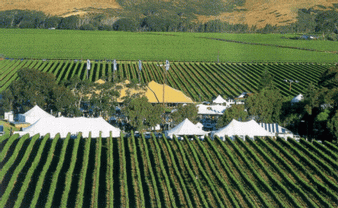History The growing of grapes and wine production is thought to have originated in the temperate regions of the Caucasus. For five or six thousand years the Assyrians and later the Pharoahs of Egypt enjoyed wine. Around the last century BC, Julius Caesar planted grapes in Bordeaux and Burgundy. Native populations mastered grape growing by the collapse of the Roman Empire in the fifth century AD. In America, Cortez planted European vines in 1524 ó native vines were already present. Cuttings brought by Jan van Riebeeck to the Cape of Good Hope, South Africa were planted in 1652. James Busby, a botanist, planted vines in Australia and New Zealand in the early part of the 19th century.

|
As early as the 4th Century AD, it is believed that Pinot Noir grew in Burgundy. This early grape was called Morillon Noir. Documentation exists regarding a Pinot grape in the 14th Century AD in the Burgundy area. Clones and Mutants Pinot Noir grapes are extremely unstable grapes. They mutate and they degenerate. Examples of mutation are Pinot Blanc, Pinot Gris, and Pinot Meunier. Degeneration results in the many clones of Pinot Noir available today. When you see names such as Dijon 777 on a label it refers to that specific clone of Pinot Noir from Burgundy. Other popular clones seen in the New World, besides the Dijon clones, are Pommard, Pisoni, Joseph Swan, and Martin Ray. Other Pinot Names Different countries around the world give Pinots different names. The chart belows identifies some of those names. |
| Germany | Italy | Eastern Europe | Switzerland / Austria | France | |
| Pinot Noir | Spätburgunder | Pinot Nero | Blauburgunder | ||
| Pinot Blanc | Weissburgunder | Pinot Bianco | Beli Pinot | ||
| Pinot Gris | Pinot Grigio | Malvoise | Pinot Beurot |
Culture Pinot Noir grows best on hill sides as it is susceptible to frost and coulure (poor fruit set). Some experts believe the best Pinot Noir grapes grow in limestone soil. In New Zealand and Australia, Dr. Richard Smith believes the hole in the ozone results in their exceptional Pinot Noir fruit .
Climate Because of itís early ripening, Pinot Noir needs a cool growing climate.
Disease The thin skinned Pinot Noir grape makes it more prone to disease than most grape varieties. These problems include mildew and rot and virsus such as Fanleaf and Leafroll.
Plantings Pinot Noir plantings exist in many countries today. The best producing areas (my opinion) are:
|
|
References:
1. Jackson, David & Schuster, Danny, 2001, The Production of Grapes & Wine in Cool Climates, Daphne Brasel Associates Ltd and Gypsum Press, ISBN 0-909049-17-3
2. Robinson, Jancis, 1999, The Oxford Companion to Wine, Second Edition, Oxford University Press, ISBN 0-19-866236-X